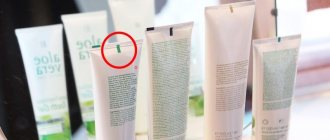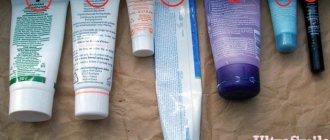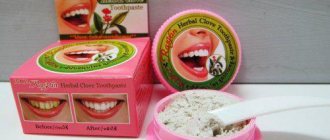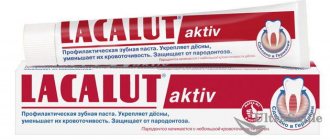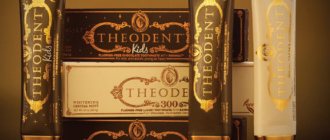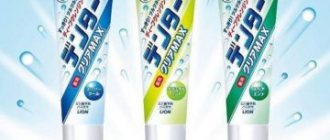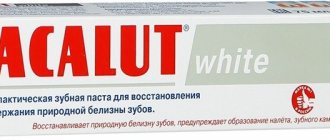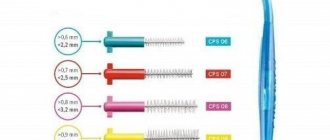There are so many different myths about what the colored stripes on toothpaste tubes mean. Allegedly, they are talking about harmful substances, the permitted frequency of using the paste, and what country or city it was actually made in. The most advanced manufacturers began to produce toothpastes in tubes with a green stripe, supporting the myth of their naturalness. But in fact, such assumptions are wrong, and any dentist can confirm this.
What do the colored stripes mean on tubes of toothpastes and creams?
There are so many different myths about what the colored stripes on toothpaste tubes mean. Allegedly, they are talking about harmful substances, the permitted frequency of using the paste, and what country or city it was actually made in. The most advanced manufacturers began to produce toothpastes in tubes with a green stripe, supporting the myth of their naturalness. But in fact, such assumptions are wrong, and any dentist can confirm this.
The true meaning of the stripes - why they mark the place of adhesion
Regarding why stripes are actually needed on tubes of paste, here you first need to note that similar marks are on all cosmetics that are sold in the same tubes. These markings can come in a variety of colors and be rectangular or square in shape. However, the location of the strip always remains the same - on the tail of the tube.
Such marks are found not only on toothpaste, but also on all cosmetic products.
So, the colored stripes on a toothpaste package have nothing to do with its composition, properties or any other characteristics important to the consumer. The purpose of these marks is very simple - they are standard markings that are applied at the stage of the production process. It is necessary for the proper operation of the conveyor and for cutting blanks for future tubes. There is a special sensor on the conveyor where the workpieces pass. It is he who recognizes the mark and, based on its location, cuts the workpiece. Then the container is sealed on one side and filled with paste.
Basic myths about color marks on tubes
According to some consumers, the colors of the stripes on tubes of toothpastes, ointments and creams indicate the characteristics of their composition:
- Red is about synthetic.
- Green is about the environment.
- Blue and brown indicate that the product is half natural.
- Black - contains only chemical components.
Another part of consumers is of the opinion that colored markers indicate the degree of abrasiveness, the presence of protective properties, or the cost of hygiene products.
| Color of the strip on the paste tube | Number of abrasive particles | Protective properties | Price |
| Red | Few | Although it contains synthetic components, it provides the required degree of enamel protection. | Expensive product |
| Green | No | Effectively protects teeth and oral cavity from diseases thanks to its ecological composition | average cost |
| Blue, black, brown | A lot of | Has a low degree of protection, provokes periodontal disease | Cheap remedy |
GOST and multi-colored stripes
A modern tube of toothpaste made in Russia must comply with three GOST standards at once:
- GOST 7983-99 (based on ISO 11609-95) talks about the correct marking of a paste mass and what it means.
- GOST 14192 and 28303 indicate the requirements for containers.
These documents state that:
- It must be indicated on the tube:
- Product name;
- brand;
- trademark;
- volume;
- compound;
- acceptable storage conditions;
- best before date;
- availability of relevant certificates.
- The marking is applied in the language of the manufacturer and the importing country.
- Permissible deviations from weight are 5%.
- Containing materials must be environmentally friendly.
But none of the GOSTs talks about the meaning of colored stripes on toothpaste and the rules for applying them. That is, the state does not regulate in any way the procedure for applying a “color barcode” ; the company itself decides the issue of marking toothpaste with colored stripes and can do without these designations.
Manicure with multi-colored stripes
Do not limit yourself to a rainbow palette; use transitions and combinations of fashionable colors of the season or simply “consonant” shades of the same color. For expressiveness, paint adjacent plates with one of the colors chosen for the stripes. By the way, the stripes don’t have to be clearly geometric; they can more closely resemble stems of grass or flashes of flame.
Why are multi-colored stripes applied?
In fact, the colored stripes on the tubes are an identification mark for the conveyor during automated production. They are necessary for high-quality separation of the tube blank from the conveyor belt.
Stripes on pastes
The technological sensor detects the color marking and cuts off the future tube of toothpaste. After this, the plastic sheet is twisted, glued and filled with gel content. After these manipulations, the tube is finally glued and closed with a cap.
The color of the mark on toothpaste, by and large, means nothing. The manufacturer can independently choose the range and height of the strips, regardless of the chemical composition of the product and the shape of the container.
Streaks on creams
Creams are marked as the products move along the conveyor belt in a non-contact manner using special color markers read by conveyor sensors. They allow you not only to correctly cut and solder the tube, but also indicate places for applying drawings and text on the container.
Information about the composition and manufacturer is applied by inkjet using special ink. That is, red, black and other stripes are needed only in the process of producing creams using robotic technology.
Why do we really need stripes?
In fact, everything listed above is truly a myth. Let's think logically: if the strip on a tube of toothpaste actually reported that it was harmful, then who would buy it? And what's the point of putting this on the label of your products? Signaling the dangers of a product by labeling toothpaste with a colored stripe is impractical and unprofitable for any business.
You need to understand that today most oral and body care products contain not only natural ingredients, but also chemical impurities that extend the shelf life, allow the products not to deteriorate ahead of time and safely endure transportation from different countries of the world .
So, what do the colors on toothpaste, specifically the colored stripes on a tube of toothpaste, mean? In fact, these tags are completely harmless; they are intended for organization and convenience of the production process. They are indicated when creating a packaging design and its implementation in production. First, tubes with a logo and descriptive information are made on the conveyor, which are pulled as a continuous ribbon before being separated. Next, robotic equipment evenly cuts the tape into equal parts - this must be done in such a way that the design of each individual package is not compromised. This is where markings come in handy, because... It is along them that the incision is made.
The color marks on the tubes are completely harmless
Modern equipment can only perceive bright and contrasting color markers. So that it can count them, black, red, green and blue are most often used. For example, if the packaging is white, then the most contrasting color will be black.
After the machine cuts the tubes, their edges are processed, glued and soldered (right at the location of the colored strip), and filled with paste.
“In GOST 7983-99 1 about the conditions for labeling toothpaste, as well as in the ISO 11609-95 standard, there are no requirements regarding what kind of stripes the toothpaste should have on the tube - the color and shape can be any. There is also no information regarding what the colors are supposed to mean. The main thing that the manufacturer needs to comply with according to the standards is to indicate the fluoride content, your address, composition, production date and expiration date, as well as special storage conditions,” says pharmacist E.V. Guseva.
The True Meaning of Flowers
Despite the simple explanation for the appearance of stripes on toothpaste tubes, a certain color is chosen for a reason. The choice of mark shade is influenced by:
- Tube color. A black (dark) stripe on the toothpaste means that the main tone of the blank and tube is white or just a light shade. Light marks are typical for dark-colored containers, but manufacturers who decide to choose this shade of marker take a risk, since the photo sensor may not “catch” it during the soldering process.
- Limited choice. Typically, the marking involves 4 basic shades (CMYK - Cyan Magenta Yellow Black). Additionally, a fifth color can be used to print a barcode, text, or one light mark.
That is, the correct reading of the marking by the optical sensor depends on the contrast of the stripe and the main color of the tube.
Most often, the tags are darker than the background, which allows the sensors to read the necessary information most efficiently. When choosing a marker shade, packaging design is no less important. This means that if there are blue elements on a tube of toothpaste, then the stripe on it will be blue. Since the stripes on tubes of creams and pastes do not mean anything important (impact on the enamel), they can easily be replaced by other design elements at the discretion of the manufacturer.
Technological photo marks can be divided into 2 types based on their position on the sheet:
- horizontal markers are placed for precise cutting of the main workpiece when printing on a rolled laminate;
- vertical marks are needed to accurately indicate the location of the cut when soldering the tube, so that it is parallel to the main text and image on the final product.
Manicure with stripes for different nail lengths
Short
This year, vertical stripes in different combinations are popular. You can have one wide plate in the middle and decorate it with, say, rhinestones. You can have different sizes on one half of the nail, multi-colored. Diagonal stripes will work too. Complement the stripes of some plates with a pattern - from the simplest graphic to multi-colored.
Long
There is freedom for any stripes here. If your nails are long and narrow, do not overuse the vertical. The nail hole looks elegant with a straight stripe. Modern gradient design and ombre stripes are trendy. Try making the stripes multi-colored by combining several colors. The stripe running down the middle of the plate may well be shiny. An interesting design can be achieved if an adhesive golden (silver) strip divides the nail into two color zones.
Labeling procedure
Color division depends on the equipment and the number of coloring sections. At the preparatory stage, one main color is taken, which will contrast most with the color of the tube. Based on it, the features of reading elements and printing a barcode are determined.
If you use two colors at once, for example, blue and black, this will lead to unreadable text when the equipment is moved. Optical sensors correctly capture one primary color (red, green). Most often, white color is used for the background, since all the colored stripes are clearly visible on white tubes; the height and width of the marks are discussed individually. This approach allows us to minimize the costs of producing and placing information on tubes using a printed, non-contact method.
But the color of the marking has nothing to do with the composition of the gel. Typically, the tubes are manufactured by a company that has nothing to do with the development of the personal care product itself and dentistry, so its labels simply by definition cannot refer to the chemical composition of the paste-like mass. If stripes on toothpaste mean anything, it clearly doesn't matter to the end consumer.
Depending on the required parameters of the tube, a large blank sheet is divided into parts of a certain size. Light marks are placed as delimiters. They indicate the location of the incision to produce a tube of the required volume. Different colors of markers help identify manufacturing defects and other technological defects.
The stripes on toothpaste do not mean anything, so you don’t need to look closely at them and look for a secret sign in them. If you need to choose a paste with some specific indicators, you should look for information about them not in strips. The content of synthetic and natural substances in the gel can be found by reading the composition information posted on the tube.
Manicure with stripes with a combination of different colors
White
Black and red stripes are a popular combination. White with multi-colored stripes of all colors of the rainbow - a summer holiday. Actually, white goes well with any other color.
Yellow
Add gray and black if you want to be on trend. Did you choose green? Please note that in the bright version it will only look good in thin, unobtrusive stripes.
Pink
It's just asking for gray and silver. What if you added lavender or mild mint? Be sure to support the orange stripe with deep burgundy - an amazing combination.
Red
Add gray and beige instead of black and white: modest and tasteful. But, in order not to get bored, support them with a gold, silver stripe or foil.
Grey
An amazing combination with black geometric stripes - especially if they are folded into a fantasy pattern. Minimalists will love the transitions from gray to beige and brown.
Squares on tubes: what do they mean?
myths circulating on the World Wide Web regarding labels on cosmetic products . The most common of them gives the following interpretation of the rectangles on the packaging:
- Black or other dark shades - the product is replete with substances harmful to health. The daily use of such “chemicals” can pose a danger to human health;
- The blue color of the square indicates a slight decrease in the concentration of synthetic components relative to the previous category. The share of natural “ingredients” reaches 1/5;
- The red square serves as a signal that the proportion of natural substances is exactly half per 100 grams of substance;
- The green color of the brand indicates that the product can be safely classified as “Organic”. The composition includes only natural raw materials, which have only a beneficial effect on health.
Alternative theory
mythological meaning is sometimes attributed to flowers on toothpaste :
- Black: composition for whitening tooth enamel. Recommended for use no more than once a week;
- Blue: the mass is suitable for everyday use;
- Red: there is a healing effect. Such products are sold in pharmacies and prescribed by dentists in case of painful teeth;
- Green: designed to consolidate the healing results achieved by the previous composition. Recommended for use within 4 weeks after the treatment course.
Other decryption options are also possible. The gradation of colors is often interpreted as a distribution by price categories of goods, where the green marker is an indicator of an elite and expensive “eco-product”.
Manicure with neon stripes
Fashionable summer cover. Pair bright stripes with negative space and black polish for a statement and bold look. Neon plays great on matte plates in contrast with black. Adjacent plates can be coated with one color of the neon spectrum.
Features of container production
Before answering the question regarding the true meaning of squares on containers, you need to provide information about the features of their production.
Creating regular tubes looks like this:
- The polymer blank is cut into pieces of a certain length and width;
- The logo, barcode, manufacturer data and other information are applied to the tube;
- Rolling up a segment that takes the shape of a cylinder;
- Sealing the edges of the sample (on one side);
- Filling the container with cream (or other substance);
- Clogging and sealing of the cylinder;
- The date of manufacture and expiration date are printed on the seam. light mark” is also affixed , thanks to which the machine recognizes the exact location where the cut needs to be made.
The specified sequence of actions is applicable to the process of manufacturing plastic products. The mechanism for creating aluminum tubes is somewhat different, but the placement of a color marker also takes place.
What do the stripes on tubes of creams mean?
We found out that there is nothing supernatural hidden behind the mysterious rectangles on the containers of cosmetic and hygiene products:
- The light mark can be any color. The main requirement for it is readability for the machine. Therefore, you need to paint the rectangle so that it is as recognizable as possible for the car and contrasts sharply against the background of the overall design of the product;
- Horizontal figures indicate the cut line, vertical ones are used as a marker for the sealing location;
- Sometimes light marks may be completely absent from the container: instead, figures disguised as design elements are used;
- International standards do not have any requirements regarding seam markers. The ISO 11609-95 standard, which describes the technology for the production of dentifrices, does not contain data on light markers.
Nude manicure with stripes
Simple black stripes are expressive here - add an accent, a small heart to the line. The negative space itself can be highlighted as a strip, covering the rest of the plate with a different color or a gentle one, close to nude. Feel free to add glitter lines, foil, glitter.
Quality assessment criteria
A high-quality toothpaste should not contain the following substances:
- Sodium dodecyl sulfate - used to form foam. It is inexpensive, so it can be found in products in the low price segment. It has a negative effect on the skin of the oral cavity, is one of the causes of early baldness, and can reduce visual acuity. It tends to accumulate in the body, so daily use of such substances is not recommended;
- Triclosan is designed to destroy and inhibit the growth of pathogenic bacteria. Along the way, it destroys a number of microorganisms necessary for health;
- Fluoride helps in the prevention of caries and other dental ailments, but is quite poisonous. If large quantities of fluoride or fluorides are accidentally ingested, poisoning may occur;
- The controlled abrasiveness index should be within 100 for healthy teeth.
On the Internet you can find a wide variety of explanations of what the stripes on toothpaste tubes mean. Allegedly, they indicate the degree of environmental friendliness or the price category of the product. But in fact, their purpose is exclusively practical and makes sense only for a machine on a conveyor belt .
Video: codes on tubes
In this video, Igor Mulatov will tell you how manufacturers label toothpaste tubes and what the green and blue squares on the packaging mean:
What does the stripe mean on cosmetic tubes?
Varya Valovil
It would seem, “How many times have they told the world…” but no! Here and there, topics that have already been chewed over several times continue to emerge. But our task, as the main organic publication, is to periodically remind who is who, or rather, to tell what is true and what is not.
Active discussions of stripes on tubes began a long time ago, but the peak moment was when Elena Malysheva said in the program “Live Healthy” that this is not just a stripe, but a secret message from cosmetics manufacturers, which no one knows about, but “I, they say, you , fools, now I’ll tell you the truth!”
Here, by the way, is this issue, I suggest you read it:
With the development of blogging and the emergence of a huge number of beauty-health-eco-shmeko blogs, this conspiracy theory has been reborn. After all, nothing motivates people to action like fear. She states that:
" Green - contains 100% natural raw materials, environmentally friendly substances Red - contains both synthetic and natural substances Black - contains substances hazardous to health"
The question immediately arises: where did the blue and white stripes go? Why didn't they say anything about them? I offer my interpretation: the tubes with the blue stripe contain only water! And in tubes with a white stripe there is air. By the way, there is also an opinion that the black stripe indicates the absence of animal testing.
As you can guess from my caustic comments, Elena Malysheva’s statements about green, red and black stripes have no basis. It is clear that my theory about the blue and white stripes is the same.
Let's move on to the serious part of the article: argumentation.
In fact, the stripes are technological markings; they serve to correctly orient the tube in the tube-filling machine. In order for the photo sensor to catch the photo tag, it must be as contrasting as possible with respect to the color of the packaging; this is the only thing that determines the color of this stripe.
There is no connection between the composition of the product and the strips for at least three more reasons:
- The green tube in the first photo in this article is Weleda SkinFood cream, the naturalness of which is confirmed by the international eco-certificate NaTrue, and the strip is “for some reason” black.
- Most aluminum tubes do not have such marks, although they produce creams, toothpastes, and much more. The fact is that aluminum tubes are not soldered, but wrapped, this is done by another machine and the need for a mark disappears.
- The Russian manufacturer of cosmetics “Nevskaya Kosmetika” (Ushasty Nyan, New Pearl, Tip-Top, etc.) posted on its website an official confirmation that the marks on the tubes are nothing more than technological markings. Maybe they produce cosmetics that are not the most environmentally friendly and natural, but there is definitely no doubt about the technological effectiveness of their production.
Apparently, the manufacturer was so tired of letters from frightened people that the marketing director himself was forced to write a paper refuting it.
What actually helps to recognize the naturalness of a product?
- Eco-labels. The most, MOST reliable source of information about the natural composition of the product. The main thing is to be sure that this is a real eco-certificate, and not an ordinary circle with a leaf inside and the inscription “100% organic.” We wrote about them here and here.
- Compound. The ability to recognize critical ingredients in a composition is extremely useful! Here are some articles that will help you figure it out: 1 and 2.
leave a comment
Related Posts
What to drink from in the new decade?
- promo
Rye and flax - a new organic and grain-based store in Reutov
How the unfavorable environmental situation in Russia slows down economic growth
Most popular
Almost no jar of cream, tube of deodorant or hair product is complete without it. Propylene glycol in
Currently reading
The Arkhangelsk Regional Arbitration Court declared the buildings on the site of the future landfill in Shies illegal and demanded their demolition. TO.
What do the colored stripes on the tubes mean?
The stripes on the tubes are technological markings. It is needed only for the production of tubes and has nothing to do with the contents of the tube and its composition.
When the machine cuts the tape and rolls the tube, it follows these marks. “Looks” at them with his “eye” - a photocell. And in order for the marking to be better visible, its color is selected from the available set based on the principle of maximum contrast with the background (material) of the tube.
For example, if the tube is white, and the print colors include black, the mark will be black, as it has the most contrast to the background. If there is no black in the color set, another, most contrasting one, will be used.
Why am I writing all this? And so that you look with contemptuous pity at those who, by the color of this label, determine “the degree of environmental friendliness and the percentage of natural composition of the components of the contents of the tube.”
My wife heard this nonsense from the mothers in the yard, and googling showed that people sincerely believe in it. Here is a typical opinion about tubes of toothpaste, taken from the website baby.ru (the first link on Google when searching for stripes on a tube):
return to "Prodkhoz - Food and Economy"
Initially, the design of the future tube is developed. For most “designers” there are only 4 colors - CMYK (Cyan Magenta Yellow Black). But not all of the designers’ ideas can be reproduced when printing in full color, so the design goes to the pre-press department for further processing, where problematic design elements are processed: unnecessary colors are removed, replaced with spot colors, color separations are made in accordance with the number of ink sections of the printing machine and etc. technological aspects.
For example, a design contains an image and text (all done in full color - cmyk). The designer assigned blue color (cyan+magenta) to the text and barcode, because he was told so by higher powers from outer space, or simply this color is in harmony with the general idea of the design, or it is the brand color of the company, etc... Print such elements by superimposing two colors on each other it is impossible, since if the colors are not combined, the text will not be readable, and the barcode will not be readable, therefore, at the pre-press stage, a spot color is assigned to this text, choosing a color from the Pantone catalog (the design will already be made in 5 colors - cmyk + pantone), therefore the photo tag will be blue, and not red or green, since an additional color is an additional expense, which the manufacturer will not agree to, trying to keep costs to a minimum.
Now about technological photo tags. Photo marks are necessary, as mentioned above: - horizontal - for precise cutting of the laminate sheet in height (when printing on a rolled laminate sheet) - vertical - for precise positioning when soldering the tip of the tube (so that the solder is parallel to the image and text part, and not under angle or perpendicular) As a rule, the mark is printed with the same ink, like a barcode.
In order for the photo sensor to catch the photo tag, there needs to be a contrast between the background and the tag. The maximum contrast is a white material and a black photo tag. If the design contains black paint, then both the photo tag and the barcode will be black; if there is no black paint in the design, then the maximum contrast color relative to the background is assigned. If the background is black/dark, then use a white photo tag. There are cases when there are no photo tags at all, and their role is played by design elements. Many manufacturers take a risk by assigning a light color to the photo tag and barcode, since the barcode may simply not be considered a scanner in a store, and the photo sensor may not catch the tag when sealing the tip of the tube. To select the color of tags and barcodes, preliminary tests are carried out, but most often manufacturers do not risk releasing a low-quality product and use black/dark color.
Common misconceptions in the interpretation of labeling
When sellers explain the meaning of color marks, you may encounter a number of myths. Some of them are even voiced by opinion leaders. To avoid confusion, we present a number of popular erroneous judgments that are not confirmed.
The meaning of the green stripe on toothpaste
- Paste with this label is completely safe for human health. In its production, only natural ingredients of plant origin are used.
- The products are intended for children and people with increased enamel sensitivity.
- The hygiene product has a strengthening effect.
- The contents of the tube are made from natural raw materials, the shelf life of which does not exceed 30 days.
- The active formula contains no substances obtained synthetically.
- There are no abrasive substances in the structure of the product. This hygienic composition can be used for daily brushing of teeth.
Considering the above features, it is safe to say that the green stripe has become an excellent marketing tool. Some manufacturers use it to stand out from other products. Sellers and distributors often tout green markers as a competitive advantage. It is important to always study the composition and build on the recommendations that are written on the tube.
The meaning of the blue stripe on toothpaste
- The composition of the hygiene product consists of 20% natural ingredients. The remaining 80% is obtained synthetically. Some of them may contain aggressive substances. Therefore, before purchasing, you need to study the information on the tube and take into account the individual characteristics of the body.
- The recipe contains dyes. They give color to the paste itself and can negatively affect human health.
- Products with a blue stripe contain abrasive substances. They help in whitening enamel. However, they do not have a powerful effect. There are no negative consequences, which means the composition can be used in daily oral care.
- The product is designed specifically for sale in the USA. It takes into account the characteristics of the oral microflora of residents of this region. When using medicinal components, the characteristics of common diseases of the oral cavity of Americans are taken into account.
- When developing the recipe, more stringent standard requirements are taken into account, which makes the product high quality.
The meaning of the black stripe on toothpaste
- The recipe contains no natural substances. All components are obtained synthetically. But this does not mean that using the product is dangerous. It is often impossible to obtain the required properties using only natural components.
- The active formula contains strong abrasives. They promote intensive teeth whitening. At the same time, rough substances negatively affect the strength of the enamel. They can scratch it and cause pain. Such products should not be used for daily hygiene. They are used in courses of 5 to 14 days in accordance with the recommendations of dentists.
- The composition contains strong dyes that can cause allergic reactions or adversely affect health.
Note! The black stripe is used on the vast majority of hygiene products, including creams, hair dyes, etc. If you carefully study each one, you can also find natural ingredients.
The meaning of the red stripe on toothpaste
- Half of the hygiene product’s recipe consists of natural plant ingredients. The remaining 50% is obtained synthetically. When choosing a product, you need to pay attention to individual intolerance to the components.
- The products belong to the medicinal category. Its formulation uses medicinal components. They are designed to eliminate oral problems without dental intervention. It is recommended to use such formulations in courses of 7 days.
- The recipe contains abrasive substances. You can use the product on an ongoing basis, but not more than three times a week.
- The red stripe toothpaste has been developed for sale in Europe. It takes into account the characteristics of the oral microflora of Europeans.
- The product belongs to the elite category. It contains special high-quality substances. This is what explains the increased cost. At the same time, you get the best quality characteristics.
Let's focus our attention once again. All arguments about quality characteristics are myths. The colored stripes on the toothpaste only indicate where the tube is cut and its orientation when sealing. There is no need to pay attention to them when choosing a hygiene product.
If you find an error, please select a piece of text and press Ctrl+Enter.
